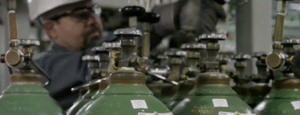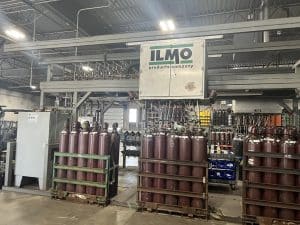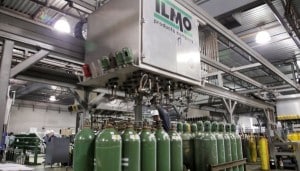Gas Cylinder Storage & Handling: Best Practices for Workplace Safety
Posted on: August 11, 2025
Compressed gas cylinders can easily become serious safety hazards if they are mishandled or improperly stored. Whether you’re in a high-volume welding shop, a precision-focused laboratory, or managing plant operations, proper handling and storage procedures are critical.
This guide shares best practices aligned with OSHA (Occupational Safety and Health Administration), NFPA (National Fire Protection Association), ICC (International Code Council), CGA (Compressed Gas Association), and UFC (Uniform Fire Code) standards so you can reduce risk, ensure compliance, and protect your team.
1. Compressed Gas Cylinder Use and Handling
How should gas cylinders be handled in the workplace?
- Cylinders must always be secured in an upright position using a cylinder cart, chain, or bracket.
- Valve protection caps must be in place when not in use.
- Cylinders must never be used as rollers, supports, or for unintended purposes.
- Cylinders should be kept away from high heat sources and not used in confined spaces.
“Compressed gas cylinders shall be secured in an upright position at all times except, if necessary, for short periods of time while cylinders are actually being hoisted or carried.” —OSHA 1926.350(a)(9)
“No one shall use a cylinder’s contents for purposes other than those intended by the supplier.” —OSHA 1926.350(c)(2)
ILMO Insight: We know you’re already wearing ten hats—and making sure everyone’s handling cylinders correctly shouldn’t be one more stressor. Let us help with onsite safety audits and OSHA-compliant training so you can feel confident your team is covered.
2. Gas Cylinder Transportation Requirements
What are the rules for transporting gas cylinders safely?
- Always use a cylinder cart with a chain or other steadying device.
- Never transport cylinders without valve protection caps in place.
- Secure cylinders vertically during transport.
- Do not lift cylinders by the valve or cap.
“When cylinders are hoisted, they shall be secured on a cradle, slingboard, or pallet. They shall not be hoisted or transported by means of magnets or choker slings.” —OSHA 1926.350(a)(2)
“Cylinders shall be moved by tilting and rolling them on their bottom edges. They shall not be intentionally dropped, struck, or permitted to strike each other violently.” —OSHA 1926.350(a)(3)
ILMO Tip: If you’re the one responsible for receiving gas deliveries while trying to keep your team safe and operations running smoothly, we understand that it’s a lot to juggle. Ask us about delivery and pickup options that can ease that burden and reduce risk during transport.
3. Gas Cylinder Storage Best Practices
Where should gas cylinders be stored?
- Store in a well-ventilated, dry, secure location away from stairs, elevators, or passageways.
- Keep oxygen cylinders at least 20 feet from flammable gases or separated by a 5-ft, half-hour fire-rated wall.
- Assigned storage areas must protect cylinders from falling objects or unauthorized access.
- Do not store cylinders in unventilated enclosures.
“Inside of buildings, cylinders shall be stored in a well-protected, well-ventilated, dry location, at least 20 feet from highly combustible materials such as oil or excelsior.” —OSHA 1926.350(a)(11)
ILMO Advantage: Whether you’re building out a new storage area or trying to make the most of a tight space, we’re here to help you get it right. Our team can work alongside you to design storage solutions that protect your people and check every compliance box.
4. Labeling
How should gas cylinders be labeled and identified?
- All cylinders must have clear, legible labels indicating contents and hazard classification.
- Never rely on cylinder color as an identifier.
- Do not use cylinders with missing or damaged labels.
“Markings shall be durable and maintained in a legible condition on the cylinder.” —CGA C-7 Standard
ILMO Solution: If you’ve ever dealt with a mystery cylinder or scrambled to meet compliance checks, you’re not alone. Our barcode-based tracking helps you keep your labeling crystal clear, and gives you peace of mind when it matters most.
5. Regulators and Caps
What are best practices for regulators, valves, and caps?
- Always use the correct CGA-approved regulator for each gas.
- Regulators must be removed and caps replaced before moving cylinders.
- Open cylinder valves slowly. Fuel gas valves should not be opened more than 1.5 turns.
- Never use force to remove stuck valves or regulators.
“Unless cylinders are firmly secured on a special carrier intended for this purpose, regulators shall be removed and valve protection caps put in place before cylinders are moved.” —OSHA 1926.350(a)(6)
“Before a regulator is removed from a cylinder valve, the cylinder valve shall always be closed and the gas released from the regulator.” —OSHA 1926.350(d)(4)
ILMO Services: We know it’s easy to overlook a worn regulator until it causes a big problem. Our team can inspect and service your equipment before that happens—so you can stay ahead of failures and focused on your real priorities.
6. Disposal
What’s the correct way to dispose of or return gas cylinders?
- Never discard cylinders in regular trash or recycling.
- Contact ILMO to discuss safe decommissioning.
“No one except the owner of the cylinder or person authorized by him, shall refill a cylinder.” —OSHA 1926.350(c)(2)
ILMO Makes It Easy: If you’ve ever hesitated about what to do with an empty or expired cylinder, you’re not alone. Connect with us, and we’ll help you make a plan to dispose of your used cylinders safely with no guesswork and no stress.
Don’t Leave Gas Cylinder Safety to Chance
Whether you’re maintaining production uptime or managing lab purity, gas safety is too important to leave to outdated processes. Connect with an ILMO expert to talk about improving the safety and dependability of your gas supply!



